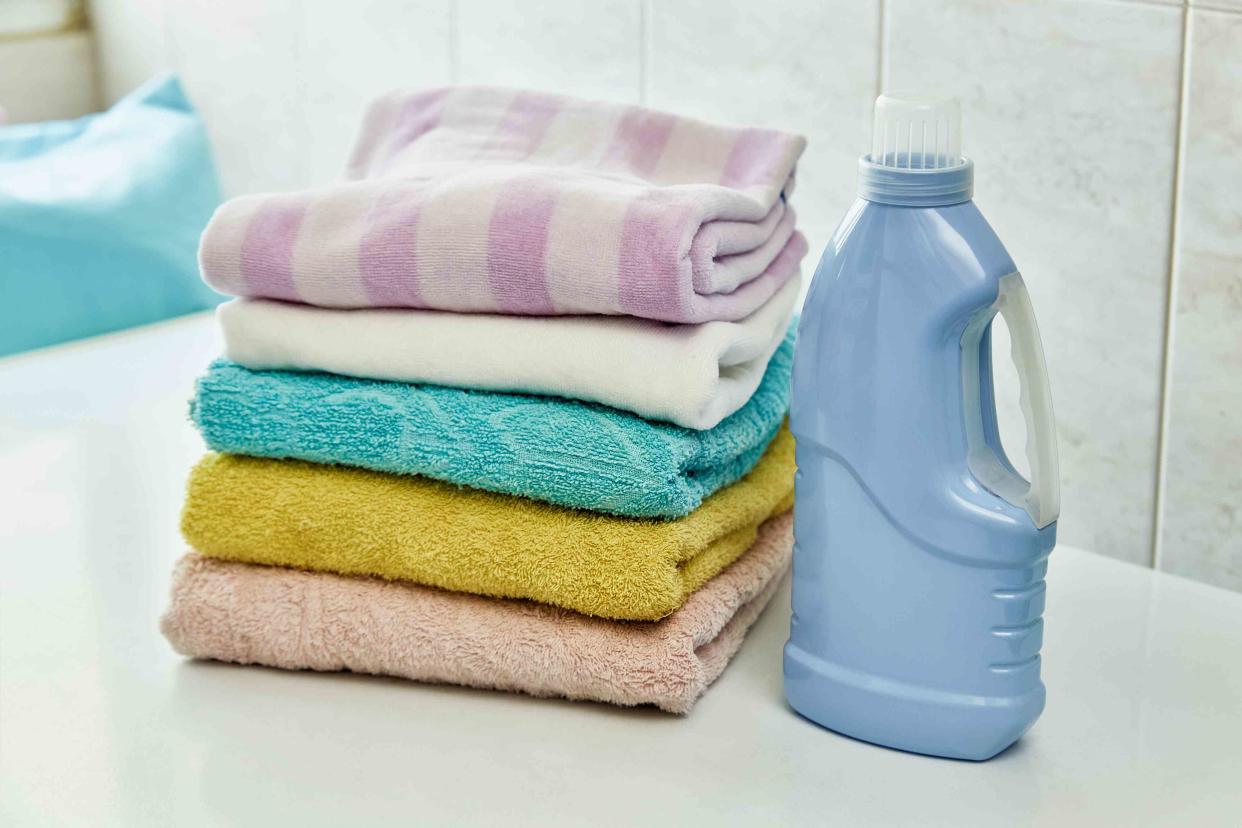What Does Fabric Softener Do? And Is it Actually Good for Your Clothes?
Read this before adding fabric softener to your laundry.

Helen Camacaro/Getty Images
There's one thing about adulthood they don’t tell you: Laundry is a monumental chore that seems to never end. That said, certain products can make the job more pleasant and even enhance the quality of your clothes and linens. Fabric softener is arguably one of those products, heralded for its ability to make your laundry smell great and feel super soft. But how does it work? And are there any drawbacks to using fabric softener? Let’s explore the benefits and dive into some considerations.
Related:Our 9 Best Laundry Tips of All Time
What Does Fabric Softener Do?
Fabric softener is a conditioner for your clothing, bedding, and anything else you launder. It’s not a cleansing agent and won’t take care of stains, nor is it a superfluous “fragrance” added for the heck of it.
“Fabric softener formulas contain fatty acids, which ultimately impacts the way your fabric feels,” explains Jessica Ek of the American Cleaning Institute. She explains that the “positively charged” fatty acids are naturally attracted to the “negatively charged” garments swirling around in your washing machine. The fabric softener lubricates these fibers and neutralizes the charge, which ultimately protects your laundry from damage and lends to a softer feel.
The result is fewer wrinkles, less static, and soft-to-the-touch fabrics. Scent is another perk, but you can also find fabric softeners formulated without fragrance if that’s your preference.
Is Fabric Softener Bad for Your Clothes?
Fabric softener isn’t bad, per se, but there are definitely some dos and don'ts to know before using this laundry additive. And ultimately, some people find that they don’t need fabric softener at all. Below are some considerations to keep in mind before adding fabric softener to your routine.
It’s Not Ideal for Moisture-Wicking Fabrics
Fabric softener shouldn’t be used on towels, sportswear, athleisure apparel, or other garments known for wicking moisture. “The fabric softener can break down the fibers in these materials,” warns Laurie Fulford, a laundry expert with SudShare.
This effect can also negatively impact the breathability of certain fabrics and garments. “Softeners run the risk of making clothes less breathable by removing the ability for a garment to pull moisture from the skin,” notes laundry expert Rechelle Balanzat of Juliette Cleaners. For a safer alternative, you can use distilled vinegar to soften these fabrics instead.
It May Irritate Sensitive Skin
Scented fabric softeners can potentially irritate sensitive skin, Fulford notes. Opt for a scent-free formula, or skip it altogether.
It Can Affect Texture Over Time
While fabric softener can lend to a soft, wrinkle-free finish, ongoing usage may negatively impact the feel of your fabrics over time. “They can potentially alter the state of the garment, making it less fluffy and more flat,” notes Balanzat.
Bottom line: Consider fabric softener a “once in a while” deep conditioning treatment for non moisture-wicking garments, including t-shirts, jeans, undergarments, and bedding. Aim to use it one out of every four to six washes of a particular garment. If you have sensitivities, it’s probably best to avoid this laundry extra altogether, or you can stick to a fragrance-free fabric softener.
How To Use Fabric Softener
Fabric softener is always added to the rinse cycle—never the wash cycle. When in doubt, follow the on-label instructions. Generally speaking, though, you can follow the below steps.
Step 1: Load Your Washing Machine
Place your laundry in the machine, making sure to avoid any textiles that aren’t suitable for fabric softener. Fabrics to avoid include terry cloth, microfiber, moisture-wicking, flame-resistant, and UPF.
Step 2: Add Fabric Softener to the Dispenser
Most washing machines have a dispenser for softener that releases it at the correct time. “If this is not the case, make sure to manually add fabric softener during the rinse cycle, as this is when it is most effective,” says Balanzat. She adds, “The softener must be poured into water pockets in order to avoid staining.” Don’t pour directly onto any fabrics. An alternative option is to use a fabric softener dispenser ball.
Step 3: Transfer to Dryer
Once your washing cycle is complete, transfer your garments into the dryer and dry per usual. Note that there’s no need to use a dryer sheet if you’ve already used fabric softener (and vice versa) since both serve a similar function.
Remember, fabric softener is completely optional, and your garments will likely pop out of the dryer feeling fresh, clean, and soft without. However, “For some, it might make doing their laundry a little more fun to use an extra product that smells very good and is colorful,” Fulford says. And there’s definitely something to be said for making this ongoing task more enjoyable.
Related:10 Laundry Mistakes You Might Be Making
For more Real Simple news, make sure to sign up for our newsletter!
Read the original article on Real Simple.
